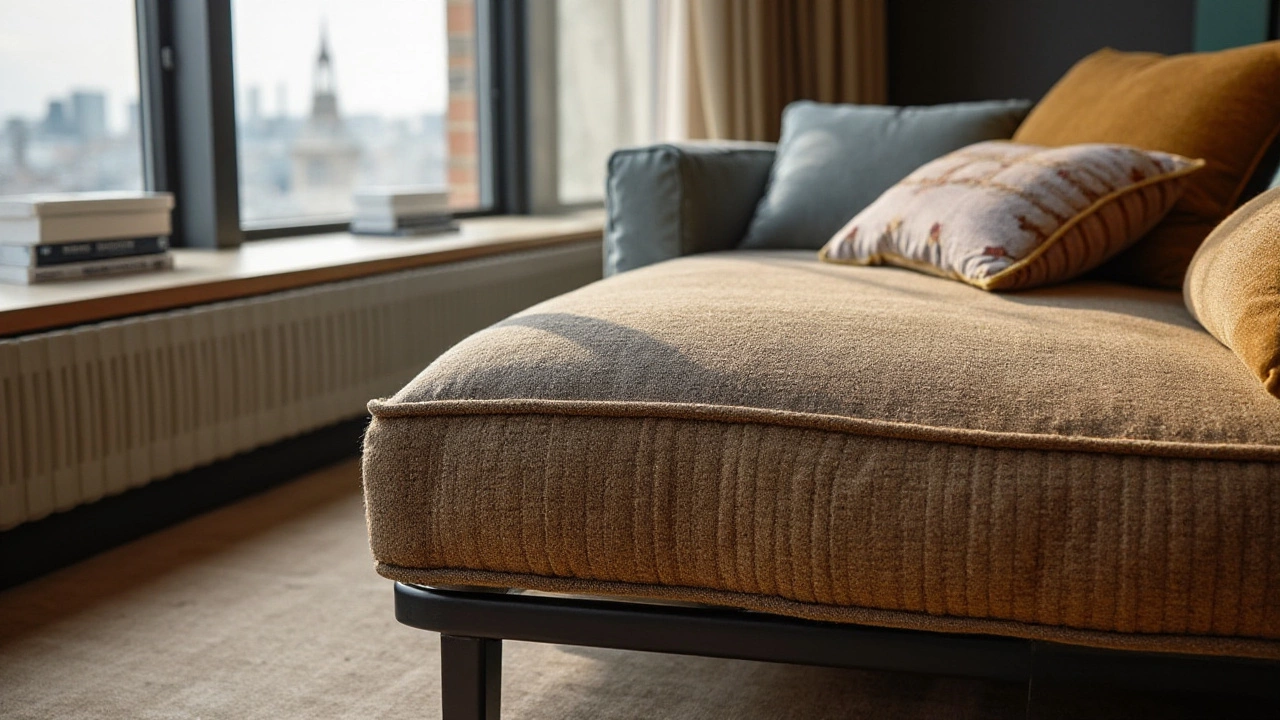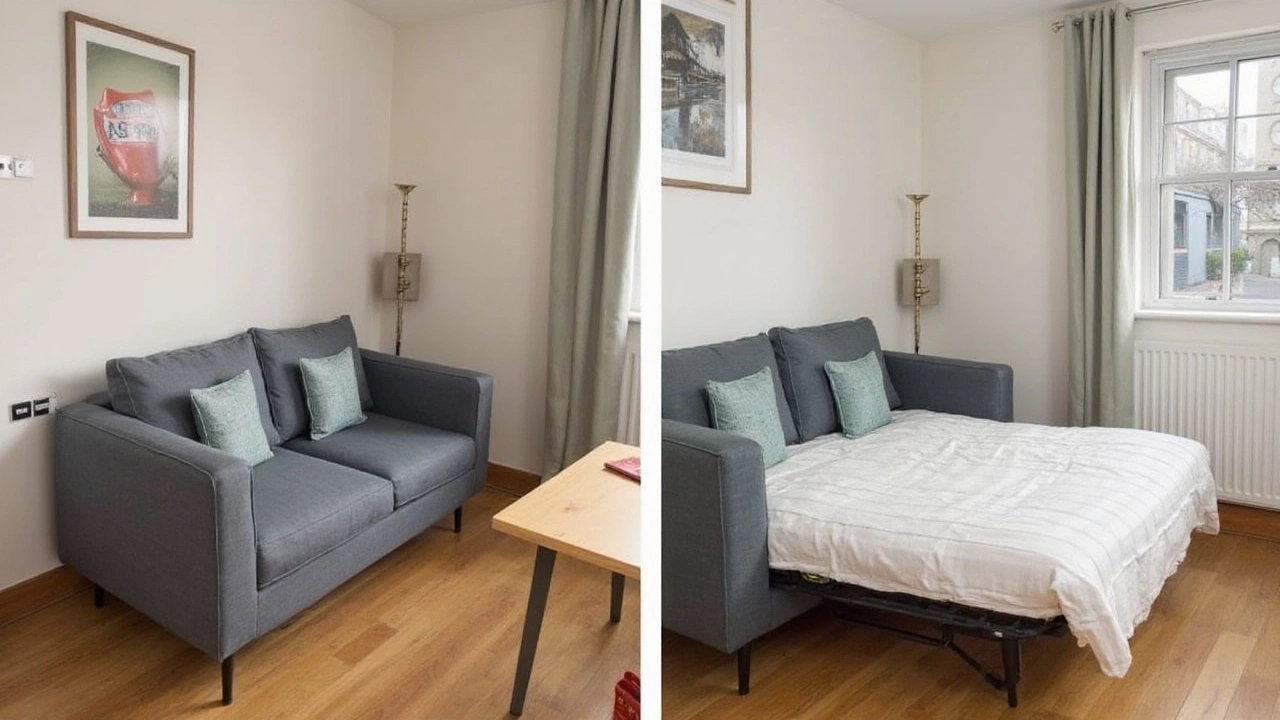Sofa beds, those multipurpose wonders of modern living spaces, bring together the world of lounging and slumber in one piece of furniture. But as you enjoy the comfort of watching telly or accommodating an unexpected guest, you might wonder how long this vital piece of comfort will last.
From gatherings to movie marathons, sofa beds undergo a great deal of wear and tear. The answer to their lifespan isn't straightforward—it depends on several factors like the materials used, the quality of construction, and how frequently they shift roles from sofa to bed and back again.
Let's explore the fascinating world of sofa beds and uncover what gives them their durability, how to take care of them, and when it might be time to start considering a replacement.
- Factors Affecting Durability
- Types of Sofa Bed Mechanisms
- Maintenance Tips for Longevity
- Signs It's Time to Replace
Factors Affecting Durability
The lifespan of a sofa bed is influenced by several critical elements, each contributing to its endurance and resilience. One of the foremost considerations is the quality of materials used in construction. High-grade frames, typically crafted from hardwoods like oak or beech, offer a robust foundation that withstands the constant shift from sofa to bed. In contrast, frames made from softer woods or composites might falter over time, creaking under the pressure of frequent use.
Equally vital are the mechanisms that allow the sofa beds to transform. Reliable mechanisms, often constructed from durable metals and designed with precision engineering, ensure smooth, unhindered transitions that do not quickly wear down. On the other hand, poorly designed mechanisms might fail, resulting in a less comfortable transformation and a shorter lifespan.
The upholstery also plays a significant role in determining how long your sofa bed will last. Fabrics like microfiber or leather resist wear and are easier to clean, while lighter, less durable materials can show wear quickly, especially in households with pets or children. Consistent exposure to sunlight can also lead to fading and damage, so placement in your home should be considered to preserve material quality.
According to interior design expert Jonathan Adler, "Investing in quality materials is key. A good sofa bed should last as long as a traditional sofa, perhaps even longer, if cared for properly."
Influencing factors don't stop at tangible components; the frequency and nature of usage are equally impactful. A sofa bed used daily as both a sofa and a bed will face more wear than one used sparingly in a guest room. The amount of weight it regularly supports can also affect its durability, with constant heavy loads leading to faster degradation.
Finally, the level of care and maintenance dedicated to a sofa bed undeniably extends its life. Regular vacuuming, spot cleaning, and occasional professional maintenance can prevent the build-up of dirt and ensure that the upholstery and mechanisms remain in good condition. Flipping or rotating the mattress part periodically helps maintain its shape and comfort, further adding to the piece's longevity. So, if you're looking to get the most out of your investment, pay close attention to these factors from the onset.

Types of Sofa Bed Mechanisms
When it comes to trying to find the right sofa beds for your space, understanding the different mechanisms that make them work is crucial. These mechanisms are the heart of the sofa bed, transforming it from a cozy couch into a comfy bed. One of the most common types is the 'click-clack' mechanism, known for its easy handling and simplicity. It works just as the name suggests: lift the seat until you hear a click, and voilà, you've got a flat surface to flop onto. This type is often favored for smaller homes because it's usually lightweight and cost-effective.
Then there's the pull-out sofa bed, which is a classic option that houses a folded mattress within the sofa. With this type, you remove the cushions and pull out the mattress, usually set on a metal frame. Pull-out mechanisms can be quite robust, offering the advantage of a thicker mattress, which means more comfort for sleepers. These are typically more suited for occasional use rather than nightly sleep since the foldable nature might cause the mattress to wear over time, especially if not folded properly each time. A quote to remember, "Form and function should be one, joined in a spiritual union," said the legendary Frank Lloyd Wright. This applies aptly to the design of these beds as they must serve dual purposes with equal finesse.
Another popular style is the futon style, which doubles up as a seat and simply bends downwards to convert into a bed. The beauty of the futon lies in its simplicity and versatility, but they are often best loved for providing a firmer bed. Futons are generally used in more modern or minimalist settings, where space-saving solutions are prioritized. While they might not always provide the plush comfort of upscale mattresses, they excel in ease of use. Finally, there’s the A-frame option that folds out from the middle by lifting the seat forward and then laying it flat.
To decide which mechanism might best suit your needs, consider who will be using the bed most frequently. Is it for guests now and then, or do you need it for nightly sleep? Each mechanism has its own perks and downsides, so aligning these with your lifestyle needs and expectations is pivotal. Keep in mind that sofa beds with metal frames and mechanisms tend to offer more durability, crucial when thinking about how long you hope your investment lasts. You'll also find some new age designs that incorporate electric power to unfold the bed, at the touch of a button, which speaks of luxury and easing convenience.
Knowing these mechanisms inside out not only helps in making a wise buying decision but also provides insights into maintaining them. Having a feel for how each operation works aids in minimizing the usual wear, ensuring a longer lifespan. With the right selection, the comfort of your sleep, as well as the style of your living room, can see a harmonious marriage. Truly, people say that the best furniture is an extension of one’s soul, which is why choosing the right sofa bed is just as personal as it is practical.

Maintenance Tips for Longevity
When it comes to extending the life of your sofa beds, it’s vital to treat them with care and attention as you would any treasured piece of furniture. By doing so, you're not only prolonging their usability, but also preserving their aesthetic appeal. Regular maintenance doesn't just stop at a weekly vacuum. It's about understanding the nuances of your sofa bed's build and materials, which can significantly sway its life expectancy. From its fabric to the internal mechanisms, each part plays a role in its durability.
Start with the upholstery. The fabric you choose dictates a lot about your sofa bed’s lifespan. Fabrics like leather and tightly woven textiles usually promise longer durability. They are designed to withstand daily wear and are easier to clean compared to their softer counterparts. Opt for regular vacuum cleaning, and tackle stains immediately with a suitable fabric cleaner. On occasion, consider a professional deep clean. Typically, doing this every 12-18 months keeps the fabric in prime condition. It's a basic regimen, yet largely ignored by many, leading to premature wear.
Then there's the internal framework of sofa beds. High-quality sofa beds often feature metal or hardwood frames. Unlike their cheaper counterparts, which might subtly sag over time, these materials provide stability and resilience. To maintain them, ensure weight is evenly distributed when folded out as a bed. While it may seem trivial, proper care in how you open and close your sofa bed can impact its longevity. Make this a ritual if you will, treating those adjustments with precision and gentleness. It's like caring for a mechanism in a vintage watch—precise and thoughtful.
Now, onto the bedding material itself. The mattress requires attention, too. Just as you’d rotate and flip a standard mattress to avoid uneven wear, so should you with a sofa bed. This ensures the foam or springs inside remain consistent, eliminating risk of lumps and bumps which can discomfort sleepers. If your model permits, consider investing in a mattress topper for added comfort and protection; it acts as a barrier, preserving the mattress surface from body oils and spills.
Incorporating these easy steps might seem a chore, but think about it as a routine—familiar yet ingrained, like brushing teeth or brewing your morning cup of tea. Following these basic measures elevates the lifespan of your furniture, turning it from a temporary stop-gap to a centerpiece fixture. After all, a sofa bed isn't just furniture, it's a companion in your home, right there with you through both everyday mundanities and vibrant celebrations.
"Good furniture stays with you for years. Treat it with the care it deserves, and it'll serve you faithfully." - British Interior Designer Annie Sloan

Signs It's Time to Replace
Deciding when to replace your sofa bed is not always straightforward. Furniture, like everything else, has a subtle way of telling you when it's reached the end of its useful life. One of the most obvious signals is discomfort. If every time you sit or sleep, you feel less supported or endure an aching back, it may suggest that the cushioning has lost its resilience. Over the years, fillings can break down due to repeated use, making it hard for the sofa bed to retain its form and functionality. Though remedies like adding additional pillows or a mattress topper might work temporarily, these are merely band-aid solutions.
Another telltale sign is the condition of the fabric. As time marches on, the upholstery might start to look worse for wear, with visible tears, fraying edges, or fading color. Quality materials play a crucial role in how long furniture, especially pieces we sit and sleep on often, retain their visual appeal and robustness. It's worth noting that odors trapped in fabric over years of use can often spell the demise of a good sofa bed. While cleaning might lift some stains or smells, certain odors persist, eventually necessitating a change.
Moreover, pay attention to the structure of the sofa bed. A sagging frame or a malfunctioning mechanism is a red flag. When the components that allow your sofa bed to easily transition from sofa to bed start failing, it diminishes its usefulness. The creaking springs or metal bars sticking into your back as you sleep might not just be annoying—they could indicate structural failure awaiting repair or replacement. Instances of cracking wood or bent metal occur when materials weaken under constant pressure, and in those cases, replacement becomes more economical than repair.
Lastly, consider style changes and personal needs. Interior design trends evolve, and your once-modern sofa bed might feel dated in today's aesthetics. Additionally, your living situation might have changed—a growing family, for example, will have different space and functional needs than a single person's apartment. Should you find your sofa bed no longer aligns with your lifestyle or decor preferences, it might be time for an upgrade.
"Good design is obvious. Great design is transparent," said Joe Sparano, reminding us how furniture should not only blend function and form but do so seamlessly, evolving with us over time.



